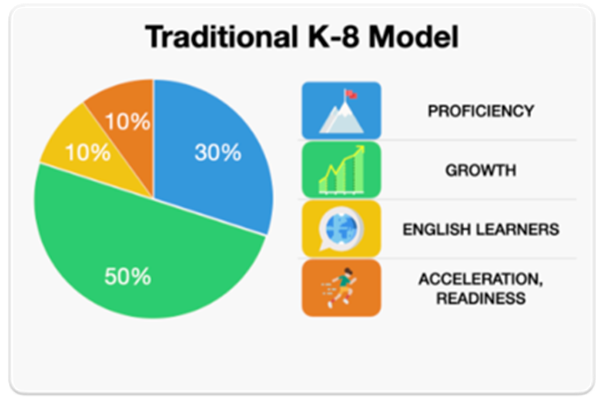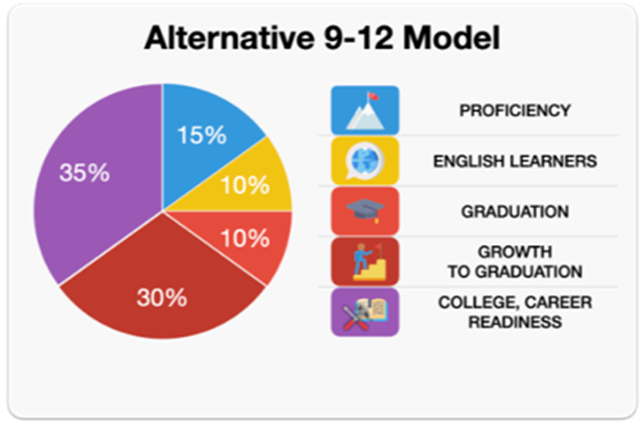Remove a school to add this one - Manage Schools
Remove a school to add this one - Manage Schools
Remove a district to add this one - Manage Districts
Remove a district to add this one - Manage Districts





These models require schools to have a minimum of ten students in each indicator to be eligible to earn the points. Schools that do not meet the minimum student threshold cannot earn points for that indicator.
| Component | Weight | Description |
|---|---|---|
| Proficiency | 30% |
The Proficiency indicator awards points to schools whose students demonstrate proficiency in English Language Arts and Mathematics. Schools earn points for students who score Partially Proficient or higher, with more points awarded for higher proficiency levels on the Arizona State Assessment as well as the Alternative Assessment. |
| Growth | 50% |
Student Growth Percentiles:The Growth Indicator awards schools’ points for the academic progress students make on the statewide assessments in math and English language arts using the Student Growth Percentile metrics. |
| EL (Proficiency and Growth on the English Learner Assessment) | 10% |
Proficiency on English Learner Assessment:
The EL Proficiency Component is designed to award schools points for English Learners (ELs) who demonstrate proficiency on the English Learner Assessment. Growth on English Learner Assessment: The EL Growth Component is designed to award schools points for English Learners (ELs) who increase their English Learner Assessment performance level score. |
| Acceleration/Readiness (Reported as one score) | 10% |
Grade 8 Math Performance:
The Component measures schools’ success in preparing students for high school Math. It incentivizes schools to annually increase their percent highly proficient and decrease their percent minimally proficient students from the prior year on grade 8 Math Arizona statewide assessment as well as the alternative assessment. Grade 3 English Language Arts: The component rewards schools for improving early literacy outcomes. It incentivizes schools to reduce the percentage of grade 3 students who are minimally proficient on the English language arts Arizona statewide assessment as well as the alternative assessment from the prior year to the current year Chronic Absenteeism: The component is designed to reduce the annual percentage of students who are absent more than 10% of the school year. Special Education Inclusion: The component rewards schools that have greater than the state average of special education (SPED) students in the general education classroom at least 80% of the day. K-8 Subgroup Improvement: The component measures the annual improvement in the proficiency points earned by several student subgroups on the Arizona statewide assessment as well as the alternative assessment on English language arts and Math. |
| Science Bonus | 0, 1.5 or 3 points |
Schools that administer the Arizona statewide science test to 95% of the students in Grade 5, Grade 8, and the 11th grade cohort can earn up to 3 bonus points based on the school’s percentage of students who reach proficiency as compared to the statewide average. |
| SPED Bonus | 0, 1, 1.5, or 2 points |
This metric awards bonus points to schools by comparing their percentage of enrolled special education students to the statewide average. |
| Component | Weight | Description |
|---|---|---|
| Proficiency | 30% |
The Proficiency indicator awards points to schools whose students demonstrate proficiency in English Language Arts and Mathematics. Schools earn points for students who score Partially Proficient or higher, with more points awarded for higher proficiency levels on the Arizona State Assessment as well as the Alternative Assessment. |
| Growth | 20% |
Student Growth Percentiles:
The Growth Indicator awards schools’ points for the academic progress students make on the statewide assessments in Math and English language arts using the Student Growth Percentile metrics. |
| 4, 5, 6, and 7-Year Grad Rate | 10% |
Graduation rate is calculated based on the 4, 5, 6, and 7-Year rates on a tiered weighting system to hold schools accountable for multiple cohorts. |
| 4 year Graduation Rate Improvement | 10% |
The component rewards schools for increasing their 4-year graduation rate as compared to their prior 4-year graduation rate. Schools can earn points for increasing the graduation rate or for maintaining a 4-year graduation rate of 90% or higher. |
| EL (Proficiency and Growth on the English Learner Assessment) | 10% |
Proficiency on English Learner Assessment:
The EL Proficiency Component is designed to award schools points for English Learners (ELs) who demonstrate proficiency on the English Learner Assessment. Growth on English Learner Assessment: The EL Growth Component is designed to award schools points for English Learners (ELs) who increase their English Learner Assessment performance level score. |
| College and Career Readiness (Reported as one score and self-reported by the school) | 20% |
The indicator is designed awards points to schools who encourage graduates to engage in a variety of activities that will prepare them for post-secondary success ranging from successful completion of a Career and Technical Education Program to performance on Advanced Placement Exams. |
| Science Bonus | 0, 1.5 or 3 points |
Schools that administer the Arizona statewide science test to 95% of the students in Grade 5, Grade 8, and the 11th grade cohort can earn up to 3 bonus points based on the school’s percentage of students who reach proficiency as compared to the statewide average. |
| SPED Bonus | 0, 1, 1.5, or 2 points |
This metric awards bonus points to schools by comparing their percentage of enrolled special education students to the statewide average. |
| ACT Aspire Participation Bonus | 0, 1, 1.5, or 2 points |
Schools earn up to 3 bonus points for administering the ACT Aspire Assessment to 9th grade cohort students in both Math and English Language Arts. |
| CCRI: Military/Post-Secondary Enrollment | 1 point |
Schools earn 1 point if:
|
| Component | Weight | Description |
|---|---|---|
| Proficiency | 15% |
The Proficiency indicator awards points to schools whose students demonstrate proficiency in English Language Arts and Mathematics. Schools earn points for students who score Partially Proficient or higher, with more points awarded for higher proficiency levels on the Arizona State Assessment as well as the Alternative Assessment. |
| Academic Persistence | 10% |
The indicator rewards alternative schools whose students continue their high school education. |
| Credits Earned | 10% |
The indicator rewards schools who help students earn credits needed toward graduation. |
| On-Track to Graduate | 10% |
The indicator rewards schools for the percent of students who are within three credits of meeting the Arizona State Board of Education graduation requirements by January 31, who graduate by the end of the fiscal year. |
| EL (Proficiency and Growth on the English Learner Assessment) | 10% |
Proficiency on English Learner Assessment:
The EL Proficiency Component is designed to award schools points for English Learners (ELs) who demonstrate proficiency on the English Learner Assessment. Growth on English Learner Assessment: The EL Growth Component is designed to award schools points for English Learners (ELs) who increase their English Learner Assessment performance level score. |
| Alternative CCRI (College and Career Readiness Indicator as self-reported by the school) | 35% |
The indicator awards points to schools who encourage graduates to engage in a variety of activities that will prepare them for post-secondary success ranging from successful completion of a Career and Technical Education Program to performance on Advanced Placement Exams. |
| Graduation Rate | 10% |
Graduation rate is calculated based on the 4, 5, 6, and 7-Year rates and schools earn points based on the highest graduation rate, to hold schools accountable to the progression of students across cohorts. |
| Graduation Rate Bonus | 6 points Maximum |
Schools earn two points per subgroups for having greater than the statewide average graduation rate for the McKinney-Vento (Homeless) Cohort subgroup, Foster Care Cohort subgroup, and/or Special Education Cohort subgroup. |
| ACT Aspire Participation Bonus | 0, 1, 1.5, or 2 points |
Schools earn up to 3 bonus points for administering the ACT Aspire Assessment to the 9th grade cohort students in both Math and English Language Arts. |
For more information regarding Arizona’s A-F Accountability System, please visit the Arizona State Board of Education Accountability Website by clicking here.
Schools that serve grades K-12, 1-12, 2-12, 3-12, 4-12, 6-11, etc. utilize both the K-8 and 9-12 models. The two models are calculated independently. The students in grades K-8 are used to determine the K-8 total points earned and students in grades 9-12 determine the 9-12 total points earned. Total points for hybrid schools are calculated using a weighted average. The weighted average is based on the students enrolled in the K-8 and 9-12 models at the start of the spring testing window.